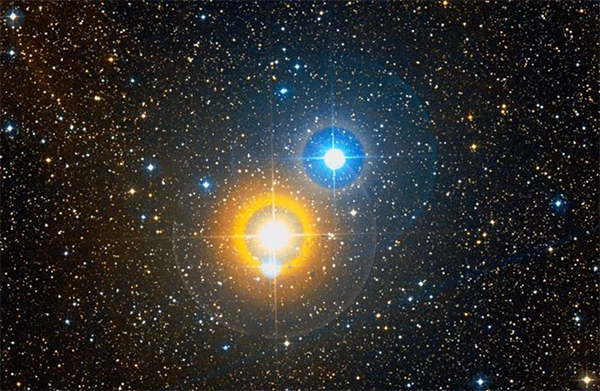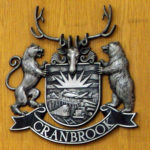Home »

A meditation on my telescopic night under the stars
By Dan Hicks
Op-Ed Commentary
The Wycliffe Exhibition Grounds are notable for more than our annual Cranbrook Professional Rodeo alone.
The Milky Way still graces its relatively dark night sky, and so it was on the clear night of October 15, from the black void beyond the perception of unaided human eyes, I conjured three deep sky objects into visibility through the lens of my Celestron 150 mm Refractor C6-RGT computerized telescope; objects dimmer than magnitude 6 (ie those with higher magnitude numbers).
I aligned the telescope with the North Celestial Pole, utilizing the Polaris polar triangle as my guide; Polaris itself – the North Star – our present polestar (magnitude 2), is actually slightly off the true pole (by 0.65 degrees), not precisely as “constant and fixed” as Julius Caesar believed.
My inspirational guide was a 2003 Skyandtelescope.com list entitled “111 Treasures for Light- Polluted Skies,” compiled by a Pennsylvanian amateur astronomer who persevered under a lacklustre light-polluted night sky that I would have dismissed as having long lost any stargazing appeal.

My first deep sky object was the famous Ring Nebula (mag 9) in the little constellation Lyra – the lyre (harp), made prominent by Vega (mag zero), our fifth brightest star in the global sky and our future polestar – 12,000 years hence. Upon entering the Smithsonian Astrophysical Observatory Star Catalog (SAO) number for the nebula, the telescope demanded that it first be realigned to a guide star – Sheliak (mag 3.5); a star in Lyra which I could locate only by referencing my Sky & Telescope Pocket Sky Atlas (it was actually a hard cover book).
After confirming that I had centred Sheliak in the telescope’s field of view using the directional buttons, it slewed to the target. The ghostly little ring apparition I beheld was the rarefied gas remnant of a supernova – an exploded red giant star, three light years across and expanding ever outward at 30 kilometres per second; revealing itself as it was 2,300 years ago, a cosmic measure of its distance from Earth in light years.
Powered by a deep cycle battery, the telescope tracked the Ring via its electric motor as the Earth rotated, causing the Ring to appear to be suspended in space. The Ring Nebula is also known as M57, the number assigned it by 18th Century French astronomer Charles Messier, a committed comet hunter, Messier listed diffuse celestial objects he observed which could be mistaken for comets; thought to be a planet at the time because of its globular appearance, M57 was labeled a planetary nebula, an erroneous but enduring classification.
My next visit was to a much closer denizen of our Milky Way Galaxy, a visible star 430 light years away – Albireo (aka Beta Cygni, mag 3.4), the head of the flying swan in the constellation Cygnus, also known as the Northern Cross.
My telescope resolved Albireo into two stars; a prominent orange star – a cool bright giant, and a dimmer sapphire companion – a hot main sequence star. But the Albireo system’s true nature is more complex – it appears to be a quintuple star system. As revealed by spectral analysis – a starlight breakdown, the orange and sapphire stars are both binary stars which have their own satellite stars orbiting them at perilously close distances; the former has two such companions, and the latter has but one.
If the two principal stars are indeed orbiting each other, than their orbital period is upwards of 100,000 years but, as their motions and speeds through space are slightly different, the two are more likely an optical double – a visual pairing of two colourful but unrelated stars positioned in a line-of-sight illusion.
My third deep sky objective was another planetary nebula, this one in the constellation Andromeda – the chained maiden.

The designated guide star was Mirach (mag 2.3), and after aligning thereto, the telescope slewed to the target location, which initially seemed to be only an empty void. But then, from out of the darkness and 6,000 years back in time, the Blue Snowball Nebula emerged (mag 8.3) – a minute bluish orb, two light years across, the ever expanding (30 km/sec) ejecta of a red giant star which erupted as a bright supernova, yet still exists within the nebula’s centre as a hot blue main sequence star (visible in larger telescopes), blazing a thousand times brighter than our sun; illuminating its unique creation – a big beautiful unmeltable “blue snowball.”

I had other deep sky objects in mind to explore but by the latter night (03:00 MDT), the great winter constellation Orion had risen to become the most prominent constellation in the southeastern sky, and the temperature had descended to minus 1 degree Centigrade; my sophisticated telescope had become disoriented, and could not be coaxed back into alignment, perhaps it was lost among the stars, as was I.
Albeit only momentarily, for those given to contemplation, an unpolluted starry night sky underscores the vastness of the universe beyond our ground bound day-to-day lives upon our lonely Blue Planet, but its strange and infinite grandeur is amplified all the more by a telescopic demonstration that there is yet again so much more beyond what we can see with our eyes alone. Yet, though ever better known with its 3,000 exoplanets, the firmament remains strangely silent; we hear no voices from the void and Fermi’s haunting paradox becomes ever more paradoxical.
But Wycliffe’s autumnal predawn was itself not silent in the least, unreflective creatures in a now moonless night – frenzied coyotes and their kin, barked out their presence from all directions in a constant canine chorus; disdainful of stealthy predation, panicking prey was their aspiration.
Southbound back to Cranbrook on the Wycliffe Park Road, after slowing to accommodate a couple of the usual skittish deer, my headlights illuminated a small herd of cow elk utilizing the snaking highway as their nocturnal travel corridor and remnant grazing meadow; were only all wild creatures as adaptable as coyotes to our pervasive landscape remodelling.
Alluring telescopic objects in our night sky need not be nebulous clouds of interstellar gas and dust, they can be the proximal, often beautiful visitors of Charles Messier’s desire – comets.
Comet 21P Giacobini-Zinner was a shy unheralded visitor in our autumnal night sky, coming closest to Earth at 3.25 light minutes away on September 10, but brightening to only magnitude 7. Discovered in 1900, it is a periodic comet with a 6.6-year orbital period.

From the rodeo grounds in the September 6 predawn, after searching among the stars of Auriga (the charioteer) with my telescope, I finally spied the comet – an ethereal little light with a discernible tail.
The year 2018 is the sesquicentennial of the Royal Astronomy Society of Canada (RASC) which held its first meeting as the Toronto Astronomical Club on December 1, 1868.
RASC’s Calgary Centre almost engaged with Cranbrook Subaru’s Night of the Falling Stars this August, but British Columbia’s notorious summer wildfires discouraged the scheduled stargazing couple who opted instead for the greater clear sky certitude offered by the South Saskatchewan Star Party in the Cypress Hills (yes – B.C. lost to Saskatchewan).
Concluding, I thank the Regional District of East Kootenay for authorizing my nighttime use of the Wycliffe Exhibition Grounds for my astronomical pursuits. Our rodeo ground’s dark starry night sky with its Milky Way is a close-by natural resource, one which has faded away over Cranbrook itself and is ever diminishing from the city’s periphery. But when Vega is our pole star, and moonless nights are clear, will the corrals still have their starlight crown?
Lead image: Apparent quintuple star Albireo resolved into “Albireo Aa” & “Albireo Ba” in the constellation Cygnus; as seen through a large telescope. Photos submitted by Dan Hicks
Background sources: Observer’s Handbook 2018 (RASC), Skyandtelescope.com, Space.com, Stars.astro.illinois.edu (Jim Kaler), & Wikipedia.org. Note – astronomical details vary with sources.







